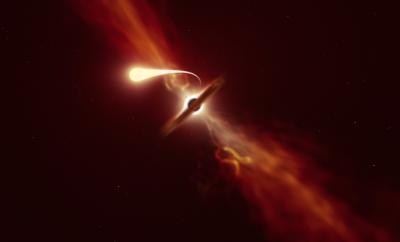A rare blast of light, emitted by a star as it is sucked in by a supermassive black hole, has been spotted by scientists using telescopes from around the world.
The phenomenon, known as a tidal disruption event, is the closest flare of its kind yet recorded, occurring just 215 million light-years from Earth. It is caused when a star passes too close to a black hole and the extreme gravitational pull from the black hole shreds the star into thin streams of material – a process called ‘spaghettification’. During this process some of the material falls into the black hole, releasing a bright flare of energy which astronomers can detect.
Tidal disruption events are rare and not always easy to study because they are usually obscured by a curtain of dust and debris. An international team of scientists led by the University of Birmingham were able to study this event in unprecedented detail because it was detected just a short time after the star was ripped apart.
Using the European Southern Observatory’s Very Large Telescope and New Technology Telescope, the Las Cumbres Observatory global telescope network, and the Neil Gehrel’s Swift Satellite, the team was able to monitor the flare, named AT2019qiz, over a six-month period as it grew brighter and then faded away.
The study’s findings are published in Monthly Notices of the Royal Astronomical Society. This was supported and funded in part by the Science and Technology Facilities Council (STFC).
“The idea of a black hole ‘sucking in’ a nearby star sounds like science fiction. But this is exactly what happens in a tidal disruption event,” says lead author Dr Matt Nicholl, a lecturer and Royal Astronomical Society research fellow at the University of Birmingham. “We were able to investigate in detail what happens when a star is eaten by such a monster.”
“When a black hole devours a star, it can launch a powerful blast of material outwards that obstructs our view,” explains Samantha Oates, also at the University of Birmingham. “This happens because the energy released as the black hole eats up stellar material propels the star’s debris outwards.”
In the case of AT2019qiz, astronomers were able to identify the phenomenon early enough to observe the whole process.
“Several sky surveys discovered emission from the new tidal disruption event very quickly after the star was ripped apart,” says Thomas Wevers, an ESO Fellow in Santiago, Chile, who was at the Institute of Astronomy, University of Cambridge, UK, when he conducted the work. “We immediately pointed a suite of ground-based and space telescopes in that direction to see how the light was produced.”
The prompt and extensive observations in ultraviolet, optical, X-ray and radio light revealed, for the first time, a direct connection between the material flowing out from the star and the bright flare emitted as it is devoured by the black hole.
“The observations showed that the star had roughly the same mass as our own Sun, and that it lost about half of that to the black hole, which is over a million times more massive,” said Nicholl, who is also a visiting researcher at the University of Edinburgh.
“Because we caught it early, we could actually see the curtain of dust and debris being drawn up as the black hole launched a powerful outflow of material with velocities up to 10 000 km/s,” said Kate Alexander, NASA Einstein Fellow at Northwestern University in the US. “This unique ‘peek behind the curtain’ provided the first opportunity to pinpoint the origin of the obscuring material and follow in real time how it engulfs the black hole.”
The research helps astronomers better understand supermassive black holes and how matter behaves in the extreme gravity environments around them. The team say AT2019qiz could even act as a ‘Rosetta stone’ for interpreting future observations of tidal disruption events. ESO’s Extremely Large Telescope (ELT), planned to start operating this decade, will enable researchers to detect increasingly fainter and faster evolving tidal disruption events, to solve further mysteries of black hole physics.
###
